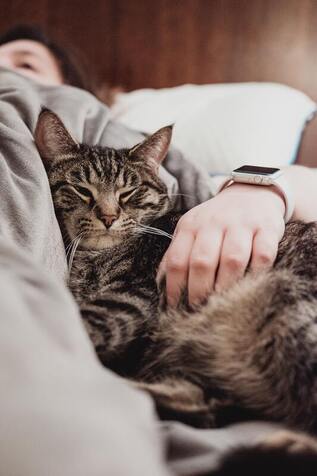With their routines changing, cats can feel unsure about their situation. When you move with pets, their scenery and smells change. This signals distress for your fur baby.
During this time, it’s important for you to remain calm and consistent. Remember that you are your pet’s most familiar anchor in the new home. If they are acting timid, unsure or following you around, you may need to be patient with them. Always remain confident, calm and consistent.
To help ease your furry friend’s anxiety, we’ve collected some of our best tips to help your pet stay relaxed during a move and adjust seamlessly to their new home.
Before Moving With Your Pet:
Cats will know something is up before the move. They will see you packing boxes and bags and can sense your mood. If you’re anxious or stressed about the impending move, your cat is likely to feel it too. There are several things you can do before the actual move to help your cat feel at ease:
- Prioritize quality time. Spend time with your cat before the move so that they are focused on you.
- Sprinkle your scent. Spray a distinct scent, such as your perfume, around your home starting three weeks before you move. Spray this same smell in the new house before your cat arrives.
- Inspect your new space for danger. Check your new house for any poisonous or hazardous items like rat poisoning/traps
- Have a vet on call. If moving cities, research a veterinarian to have on call in the new city—just in case.
- Update the paperwork. License your cat according to local ordinances, update their identification tags and contact your cat’s microchip or registry to update your contact information. Don’t have any of those things? Learn more about them here.
- Crate train beforehand. If your cat will need to be crated during the move, ensure they are crate trained so the new situation doesn’t stress them out.
- Condition for success. Condition your cat by having a few boxes and suitcases out ahead of time, before the move. That way they don’t associate those objects with you leaving.
During the Move with Your Cat:
On moving day, it’s important to remember to keep your cat safe, calm and contained. Thousands of pets run away during relocations each year and many never find their way home. You can minimize the chances of this happening to your beloved companion and make their move a lot more enjoyable if you keep these tips in mind.
- Minimize anxiety with a toy. During busy packing activities keep your cat in their crates with a toy to keep them occupied.
- Ask for help watching your pet. If you need to, have a friend or family member watch your cat to keep them away from the hustle and bustle of moving.
- Build a safe space. Your cat may become scared when the moving boxes start to take over. Ensure they don’t run out the door by keeping them in a safe space where they can’t get lost or hurt.
- Keep them tagged. Make sure your cat has proper identification and tags on during a move, in case they get out.
- Medicate them if necessary. If your cat gets anxiety during the move, consider a veterinarian prescribed anti-anxiety medication or thunder shirt.
- Feed them lightly. Feed your pet lightly the day-of the move, especially if they will be in the car for long periods of time.
Once you’re all moved in, it’s important to make your cat feel like they are home, too. There are several things you can do around your new place to ease any fears your cat may have about abandonment or unfamiliarity. You should send non-verbal signals that they are safe, loved and a permanent part of your new home.
- Introduce cats to one room at a time. When you get to your new home, introduce the new space to your cat slowly. Confine them to one room at first, then slowly introduce the rest of the house.
- Make a house a home. Place your cats bowls, bed and leash in the same room in the new house as they were in the old house. This will help make the new spaces more familiar.
- Stick around the house. Plan to be home with your cat the first few days after the move. At first, leave the house for short periods of time to see how they react. Then, when you need to be away from the house all day, your cat will feel more comfortable.
- Reassure them with treats. Leave treats and familiar toys with your cat when you depart the house, at least for the first few weeks.
- Get on their level (literally). Spend time on the floor with your pets. This will not only give them personal attention but will help your scent sink into the floor faster, making them feel more comfortable.
- Watch for signs of trouble. Observe your cat’s behavior. If they show signs of stress like refusing to eat, coughing or they have diarrhea, you may need to take them to the vet.
- Be consistent. Keep your daily routine as close as possible to the way it was before the move. Feeding, playtime and cuddle time should all happen at a consistent time.
During the move, remember to be patient with your furry friends. Yes, there may be accidents due to stress or changing schedules. But the more you are able to monitor them and, if necessary, restrict their movements, the less chance this will happen.
Finally, be careful not to correct your cat excessively, as that could just stress them out more. It should take your pet around three weeks to adjust to their new home. As you become more relaxed and comfortable in your new environment, your pet will too!
Article written by our friends at HireAHelper.com
Photo #1 by Qijin Xu on Unsplash
Photo #2 by Chris Abney on Unsplash







 RSS Feed
RSS Feed

